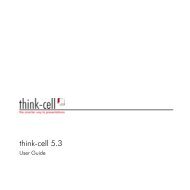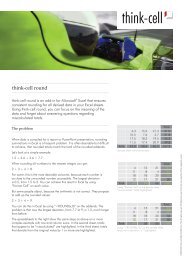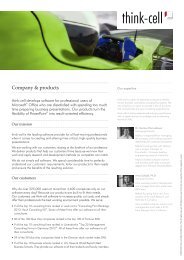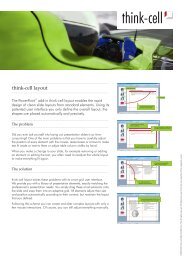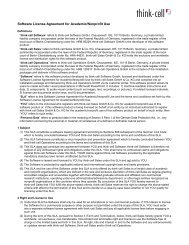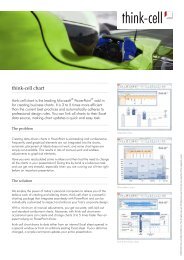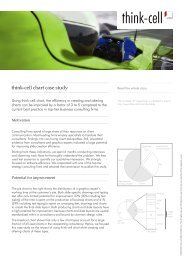think-cell technical report TC2003/01 A GUI-based Interaction ...
think-cell technical report TC2003/01 A GUI-based Interaction ...
think-cell technical report TC2003/01 A GUI-based Interaction ...
You also want an ePaper? Increase the reach of your titles
YUMPU automatically turns print PDFs into web optimized ePapers that Google loves.
1 Introduction<br />
INTRODUCTION<br />
“Layout refers to the process of determining the sizes and positions of<br />
visual objects that are part of an information presentation. Automated<br />
layout refers to the use of a computer program to automate either all or<br />
part of the layout process. This field of research lies at the crossroads<br />
between artificial intelligence and human computer interaction.”<br />
Lok and Feiner in [LF<strong>01</strong>]<br />
This thesis deals with the human-computer interaction part of a new approach<br />
for automated layout. With the notion of automated layout I do not refer to graph<br />
layout or VLSI layout. These fields of research share some of the terminology<br />
used throughout this text, albeit with some subtle differences in meaning. The<br />
application domain of my automated layout approach are business slides, which to<br />
date are typically designed with Microsoft PowerPoint 1 .<br />
A field study in a business consultancy, which is detailed in chapter 2, showed<br />
that the tools provided by standard software like PowerPoint are not adequate<br />
for efficient slide design. For example, business slide layout typically consists of<br />
carefully aligned text boxes and arrows. Since the alignment tools provided by<br />
PowerPoint are merely pixel-<strong>based</strong> and do not create lasting relationships between<br />
shapes, setting up a completely aligned layout is a tedious task. In particular,<br />
when some more text or some new element needs to be integrated into an existing<br />
slide, the entire layout must be updated manually until all requirements are met.<br />
Standard requirements are: Certain shapes must have the same size, all text must<br />
have the same formatting, all shapes must be horizontally and vertically aligned<br />
with some other shapes.<br />
The most regular, grid- or table-like layouts that prevail on typical business<br />
slides are apparently suitable for automated layout support. By automated layout<br />
support I mean the implicit or explicit specification of relations between drawing<br />
elements, and the dynamic maintenance thereof during an interactive layout process.<br />
A review of the available literature on automated layout is given in chapter 3. It<br />
turns out that a number of constraint-<strong>based</strong> systems for automated layout have<br />
been developed in research, but none of them have been successfully applied in<br />
practice. This observation is commonly attributed to the fact that those systems are<br />
very complex and therefore hard to use. However, the idea of user-specified layout<br />
constraints that are interactively maintained when the layout changes, appears to<br />
be an appropriate concept for professional slide design.<br />
The start-up company <strong>think</strong>-<strong>cell</strong> 2 elaborated on that idea and is now developing<br />
an add-in for PowerPoint that realizes constraint-<strong>based</strong> layout automation. They<br />
already implemented an architecture, which allows software-driven interaction with<br />
1All company and product names used in this text are trademarks or registered trademarks of<br />
their respective owners.<br />
2My work is <strong>based</strong> on and part of a product from <strong>think</strong>-<strong>cell</strong> Software GmbH, Berlin, which is<br />
called <strong>think</strong>-<strong>cell</strong> layout. At the time of writing, it is in early development stage.<br />
http://www.<strong>think</strong>-<strong>cell</strong>.com<br />
7



